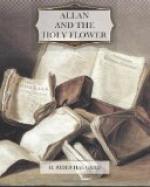By three in the afternoon the shores of the island we were approaching —if it really was an island, a point that I never cleared up—were well in sight, the mountain top that stood some miles inland having been visible for hours. In fact, through my glasses, I had been able to make out its configuration almost from the beginning of the voyage. About five we entered the mouth of a deep bay fringed on either side with forests, in which were cultivated clearings with small villages of the ordinary African stamp. I observed from the smaller size of the trees adjacent to these clearings, that much more land had once been under cultivation here, probably within the last century, and asked Komba why this was so.
He answered in an enigmatic sentence which impressed me so much that I find I entered it verbatim in my notebook.
“When man dies, corn dies. Man is corn, and corn is man.”
Under this entry I see that I wrote “Compare the saying, ’Bread is the staff of life.’”
I could not get any more out of him. Evidently he referred, however, to a condition of shrinking in the population, a circumstance which he did not care to discuss.
After the first few miles the bay narrowed sharply, and at its end came to a point where a stream of no great breadth fell into it. On either side of this stream that was roughly bridged in many places stood the town of Rica. It consisted of a great number of large huts roofed with palm leaves and constructed apparently of whitewashed clay, or rather, as we discovered afterwards, of lake mud mixed with chopped straw or grass.
Reaching a kind of wharf which was protected from erosion by piles formed of small trees driven into the mud, to which were tied a fleet of canoes, we landed just as the sun was beginning to sink. Our approach had doubtless been observed, for as we drew near the wharf a horn was blown by someone on the shore, whereon a considerable number of men appeared. I suppose out of the huts, and assisted to make the canoe fast. I noted that these all resembled Komba and his companions in build and features; they were so like each other that, except for the difference of their ages, it was difficult to tell them apart. They might all have been members of one family; indeed, this was practically the case, owing to constant intermarriage carried on for generations.




